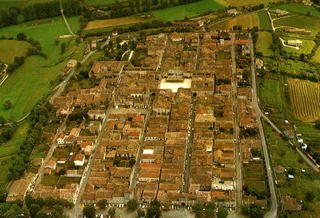
Bastides are small fortified towns which were built in France from the 13th century. Many survive to this day, particularly in Lot and the Dordogne. I have visited several, but I did not understand their significance until I read this Wikipedia article.
Before the bastides were built the peasants either lived in isolated hamlets dotted about the countryside, or in houses clustered around castles or monasteries. The bastides were built to create trading centres. An entrepreneur would set up a bastide and try and attract peasants and traders to it. The deal for the peasants was that once in the bastide they were free and had their own land; the deal for the entrepreneur was that he got to tax the peasants and the trade that the bastides generated. When the peasants had been dotted all over the landscape they had been difficult to tax and it had been hard to get any worthwhile trade going. Trading was much easier in the bastides because they had large covered marketplaces.
I found all this interesting for two reasons. The first is that what had been pleasant places to visit whilst on holiday were the products of medieval entrepreneurship and town planning. The bastides were also major social innovations and part of the decline of feudalism.
The second reason that I was interested in bastides is that that there is something very similar in Scotland. When David I became King of Scotland in 1124 he thought his country was backward, and he started construction of a number of burghs, or trading towns. Forres, Elgin, Crail, Berwick and Lanark are all burghs. The burghs were built for the same reasons as the bastides; to encourage trade and generate tax revenue. Merchants who moved into a burgh were given a feu. These were plots of land of about 25 feet by 430 feet which butted onto the marketplace. In many burghs the older part of the town still follows the original plan and the feus can be clearly seen. Burghs would also have a castle and a tollbooth. The latter was for the purposes of tax collection.
The January 1995 edition of the Scots Magazine has a good article on the Scottish Royal Burghs. There is also this Wikipedia article.
Both the French and the English built bastides in France. The one in the illustration is an English bastide called Monpazier. It was built in the Dordogne in 1284 by Edward I of England.

No comments:
Post a Comment